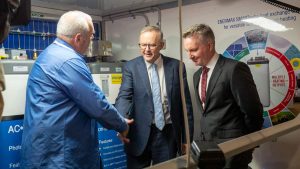A controversial national electricity market transmission reform model has been scrapped and replaced with a handful of new industry-led proposals for managing grid congestion, in what as seen as a major step forward for green energy investment.
The decision will affect multiple gigawatts of renewable energy generation and storage capacity that are lined up to be installed on the grid, but face uncertainty about the rules and costs of grid location and connection.
In a consultation paper published on Thursday, the Energy Security Board put forward a shortlist of four models proposed to guide developers on the best locations for new solar, wind and big battery projects.
These are designed to avoid both network congestion and investment pitfalls, such as curtailment and increased project costs.
The ESB was tasked by the National Cabinet to submit a proposed rule change on transmission access reform by December 2022, and last year tested the waters with its preferred congestion management model (CMM), adapted for Renewable Energy Zones.
The CMM proposed providing a sort-of “congestion rebate” to generators who located within a REZ, or potentially also non-REZ areas where there was spare hosting capacity, through complicated changes to intra-regional settlement mechanisms.
But the concept was not well received.
Critics across the industry said it was an overly complex solution to a problem with complexity at its root – one industry insider described transmission access reform to RenewEconomy this week as a “regulatory quagmire.”
And they said it did not do enough to solve the problem of investor uncertainty, which – thanks to a surfeit to recent regulatory change – is already threatening to slow the pace of the transition to renewables required to meet even the lowest of climate and decarbonisation goals.
“This mechanism could create uncertainty for investment in new generation and do nothing to support the development of a 21st century grid and much-needed investment in transmission,” a letter signed by a group of leading clean energy investors said at the time.
“We believe that there are far better approaches to addressing congestion in the energy system.”
Happily, the ESB appears to have taken on board much of this feedback.
“Based on stakeholder feedback and further analysis, the ESB proposes to take the REZ adaption of the CMM, as previously recommended in the Post 2025 review, off the table,” the consultation paper says.
“[Instead, we] propose to focus on developing a congestion zone/connection fee-based model. We have made this change in response to stakeholder concerns that exposing generators to congestion charges, without the benefit of a rebate, could inefficiently stifle new entry outside REZs.
“The congestion zones model also has the advantage that it provides a clear locational signal that can be incorporated into investment decisions.”
To this end, the ESB has whittled down 18 stakeholder submissions on alternate models to a short-list of four for stakeholders to review: Congestion zones with connection fees; CMM with universal rebates; Transmission queue; and Congestion Relief Market.
Among the four, the CRM, which was put forward by Edify Energy and is being backed by the Clean Energy Council, would send signals to developers of battery storage and others load-shifting technologies on the best sites to support a renewable grid.
This is considered particularly important going forward because, as the ESB put in the consultation paper, “current market design treats batteries as if they were generators and does not reward them for the role that they could play in alleviating congestion.”
Consequently, the ESB goes on to explain, this means it currently makes commercial sense to build batteries in locations where there is plenty of spare transmission capacity, such as former coal plants, rather than in areas were they could best support renewables and boost reliability and decarbonisation.
Another of the four proposed models, the “transmission queue,” was put forward by the Clean Energy Investor Group, which had also been highly critical of the CMM(REZ), for its failure to deliver a long-term locational price signal for investors.
CEIG says this marks the first time the ESB has put forward an investor-led alternative to proposed energy market reforms.
“For the first time an investor led proposal has been included in a shortlist of priority reform options from the ESB,” CEIG CEO Simon Corbell said.
“Investors have proposed a solution that will unlock tens of billions of dollars to develop new clean generation and storage assets in the National Electricity Market,”
“That investment is critical for energy security as ageing coal power stations become less reliable and their owners bring their retirement dates forward.
“CEIG has participated in the ESB’s process at the highest level to help achieve this outcome for clean energy investors.
“We strongly welcome the focused work done by the Energy Security Board under its new Chair Anna Collyer who is also the AEMC’s Chair,” Corbell said.
The CEC has also welcomed the alternative proposals put forward in the ESB consultation paper as a positive step forward in one of the oldest debates in the history of Australia’s National Electricity Market.
“The Clean Energy Council is working closely with industry to determine whether the models proposed by the ESB are appropriate and whether they will be effective,” a statement on LinkedIn said on Thursday.
“Drawing on our members’ collective knowledge and experience, we will continue to engage with the ESB. Our goal is to ensure that the ESB choose options to accelerate the transition to a decarbonised power system.”








